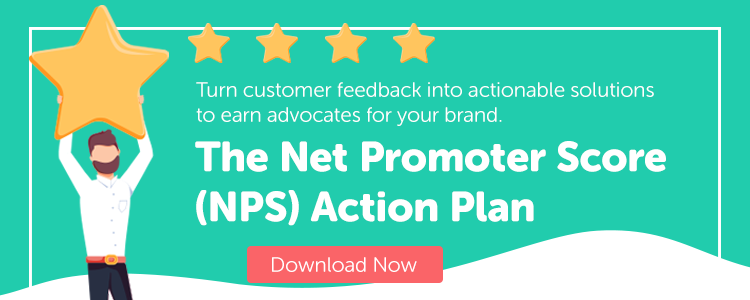Net Promoter Score (NPS) is one of the most important metrics in your business.
It not only shows your level of customer service success, but gives you a barometer of the overall health of your brand. By telling you whether your customers would actively promote your goods and services to their own contacts, it can serve as a North Star that guides you toward growth.
But NPS alone isn’t enough for your Net Promoter Score report.
In fact, absolute NPS doesn’t mean much of anything. It’s only when you chart movement in your NPS over time that you see the business success factors you can control. It’s up to the other items in your NPS report to provide the necessary context to drive positive change.
Context is king – so here’s how you can integrate it throughout a Net Promoter Score report:
1. Follow Best Practices in Statistics

When you capture your NPS, you’re not extracting data from thousands of people, only from a small subset of customers who choose to volunteer information. With that in mind, it’s vital to get as many responses as possible – ideally, more than 100 – for each reporting period.
No matter what your sample size is, always specify the margin of error. Margin of error is an interval estimate that effectively measures how reliable a data set is. As your sample grows, margin of error improves (shrinks) since errors introduced by random sampling become less likely.
Remember: Ensuring sound statistics is the key to identifying real change over time.
2. Help Front Line Staff Improve Response Rates
Higher response rates are better, but what’s the best way to induce participation? Unfortunately, incentivizing a response can skew results. Plus, multiple failed attempts to get people to submit scores could cause them to “tune out” requests like this in the future.
There’s no perfect solution, but one way is both elegant and effective.
Front line staff can make responses more likely by letting customers know in advance they may receive a survey. Explaining the importance of the survey and their responses can help customers feel invested – everyone wants their voice to be heard!
3. Report on a Regular Basis – At Least Monthly

Once you issue your first Net Promoter Score report, the race is on!
To ensure an “apples to apples” comparison of your data in the future, it’s absolutely crucial that you collect it on a regular basis. Most enterprises find that quarterly reporting fails to pinpoint changes as they happen, while weekly reporting doesn’t offer sufficient clarity to take action.
Monthly is a good goal for most organizations. Some will even develop the capacity to collect and use NPS feedback bimonthly. A consistent process for data collection that leverages automation will help you fight inertia and keep things on schedule.
4. Illuminate Your Score Drivers
NPS is fun to look at, but NPS score drivers are the real star of the show.
Score drivers are the controllable factors you can work on in the future to keep your NPS score moving in the right direction. Since people only consider and compare a few things at a time, you’ll often discover just a few attributes of your product or service are responsible for your score.
For both your customers’ well-being and yours, keep drivers to less than seven total. Remember that you can always collect freeform comments and conduct post-sale interviews to uncover drivers you didn’t think of originally.
5. Proactively Manage Service Recovery

Service recovery refers to concerted efforts to resolve complaints from dissatisfied customers and convert them back into brand loyalists. This is a big deal when it comes to your Net Promoter Score report, since dissatisfied customers grant low scores that have an outsized effect on results.
To ensure service recovery is on target, always track:
- The number of customer service requests closed.
- The speed with which those requests are addressed.
As these figures get better, your pool of low-end NPS scores will shrink.
6. Account for Time of Year in Reporting
Net Promoter Scores usually reflect some level of seasonal variance you have limited influence over. These fluctuations are based on the annual patterns of your market. For example, if you serve tax preparation businesses, you’ll get more complaints as activity increases in March and April.
Maintain your awareness of these patterns by comparing NPS results to the same period in the previous year. Forgetting to widen your perspective this way could leave you looking for holes in your process that don’t actually exist.
Integrate these six ideas into your Net Promoter Score report and it’ll be an even more valuable decision-making tool.
Not only will you move forward with continuous process improvement, but you can do so confident you’re interpreting and applying your data with total accuracy.


Rob Steffens
I am the Director of Marketing here at Bluleadz. I'm a huge baseball fan (Go Yankees!). I love spending time with friends and getting some exercise on the Racquetball court.